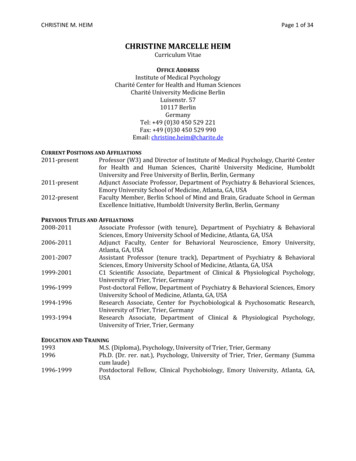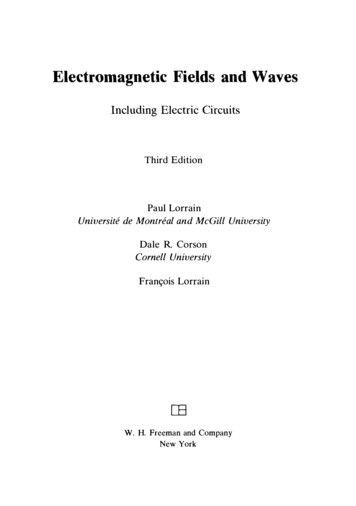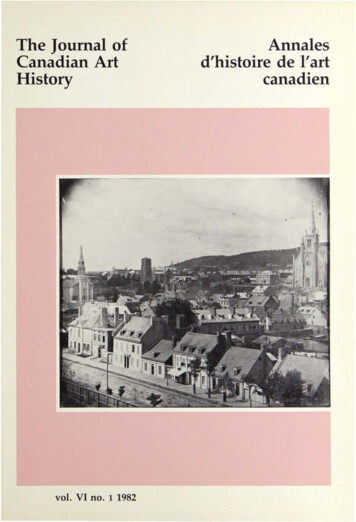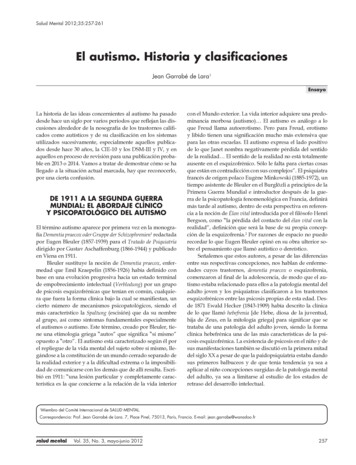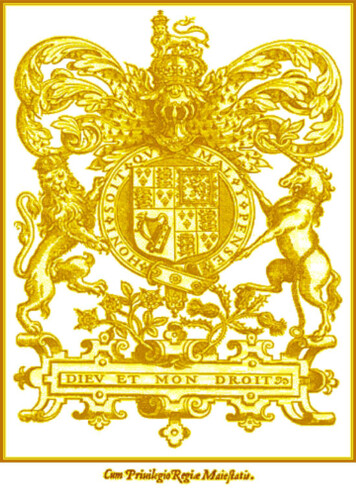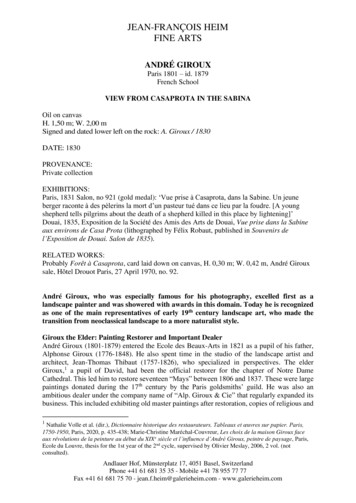
Transcription
JEAN-FRANÇOIS HEIMFINE ARTSANDRÉ GIROUXParis 1801 – id. 1879French SchoolVIEW FROM CASAPROTA IN THE SABINAOil on canvasH. 1,50 m; W. 2,00 mSigned and dated lower left on the rock: A. Giroux / 1830DATE: 1830PROVENANCE:Private collectionEXHIBITIONS:Paris, 1831 Salon, no 921 (gold medal): ‘Vue prise à Casaprota, dans la Sabine. Un jeuneberger raconte à des pèlerins la mort d’un pasteur tué dans ce lieu par la foudre. [A youngshepherd tells pilgrims about the death of a shepherd killed in this place by lightening]’Douai, 1835, Exposition de la Société des Amis des Arts de Douai, Vue prise dans la Sabineaux environs de Casa Prota (lithographed by Félix Robaut, published in Souvenirs del’Exposition de Douai. Salon de 1835).RELATED WORKS:Probably Forêt à Casaprota, card laid down on canvas, H. 0,30 m; W. 0,42 m, André Girouxsale, Hôtel Drouot Paris, 27 April 1970, no. 92.André Giroux, who was especially famous for his photography, excelled first as alandscape painter and was showered with awards in this domain. Today he is recognizedas one of the main representatives of early 19th century landscape art, who made thetransition from neoclassical landscape to a more naturalist style.Giroux the Elder: Painting Restorer and Important DealerAndré Giroux (1801-1879) entered the Ecole des Beaux-Arts in 1821 as a pupil of his father,Alphonse Giroux (1776-1848). He also spent time in the studio of the landscape artist andarchitect, Jean-Thomas Thibaut (1757-1826), who specialized in perspectives. The elderGiroux,1 a pupil of David, had been the official restorer for the chapter of Notre DameCathedral. This led him to restore seventeen “Mays” between 1806 and 1837. These were largepaintings donated during the 17th century by the Paris goldsmiths’ guild. He was also anambitious dealer under the company name of “Alp. Giroux & Cie” that regularly expanded itsbusiness. This included exhibiting old master paintings after restoration, copies of religious and1Nathalie Volle et al. (dir.), Dictionnaire historique des restaurateurs. Tableaux et œuvres sur papier. Paris,1750-1950, Paris, 2020, p. 435-438; Marie-Christine Maréchal-Couvreur, Les choix de la maison Giroux faceaux révolutions de la peinture au début du XIX e siècle et l’influence d’André Giroux, peintre de paysage, Paris,Ecole du Louvre, thesis for the 1st year of the 2nd cycle, supervised by Olivier Meslay, 2006, 2 vol. (notconsulted).Andlauer Hof, Münsterplatz 17, 4051 Basel, SwitzerlandPhone 41 61 681 35 35 - Mobile 41 78 955 77 77Fax 41 61 681 75 70 - jean.f.heim@galerieheim.com - www.galerieheim.com
JEAN-FRANÇOIS HEIMFINE ARTSlandscape paintings and also modern pictures that he rented out or sold. He also sold artists’materials, decorative arts, furniture and paper. His love of painting was reflected in hiscollection of pictures from the Dutch, Italian and French schools.2Institutional Recognition as a PainterAndré Giroux exhibited at the Salon for the first time in 1819, when he was only 18 years old.The figures in the pictures he showed had been painted by Auguste-Xavier Leprince (17991826), who doubtless passed on his interest in the realism of the Dutch and Flemish schools.Giroux was awarded a second class medal at the 1822 Salon for his submission of five realistlandscapes including a study from nature. The same year, he won a gold medal at the Lille3Salon and then in 1825, he was awarded the Grand Prix de Rome in the “historical landscape”4category, for The Hunt of Meleager (Paris, École des Beaux-Arts).5As a pensionnaire at the Villa Medici in Rome from 1826 to 1829,6 Giroux painted largenumbers of studies in oil directly from nature. He joined a group of young landscape artists thatincluded Edouard Bertin (1797-1871), Théodore Caruelle d’Aligny (1798-1871) and LéonFleury (1804-1858). He also lived, from January to May 1826, with Camille Corot (1796-1875),but their probable relationship is not documented. His oil sketches appear nevertheless to relateto the ones Corot painted during the same years and depict the same sites.7Daring to Exhibit his Sketches at the SalonIn 1827, Giroux sent an Italian landscape painted in the studio to the Salon, to which he addedmore spontaneous studies painted from nature in the Roman countryside.8 This was aninnovation because these oil sketches created en plein air by many painters had until then onlybeen shown to intimates and were often exhibited in their studios as a source of inspiration.9Pierre-Henri de Valenciennes had written, “It is true that these studies are not paintings, but wekeep them in portfolios to consult them and when needed to use them.”10 Corot for example,showed two finished landscapes at the 1827 Salon, which had been made in the studio. Hisfamous painted sketches which were so admired by the artists of his circle11 would only beDispersed at an auction on 24 and 25 February 1851 in Paris, Alphonse Giroux’s collection included LaPourvoyeuse by Jean Siméon Chardin, Paris, Musée du Louvre.3Giroux exhibited in Lille in 1822, 1825 and 1834, Douai in 1823, 1833 and 1835 and Valenciennes in 1835.4The “paysage historique” genre had been recognized officially in 1816, when the Académie created a GrandPrix de Rome, awarded every four years from 1817 to 1863. This was a composed landscape that combined themost beautiful elements observed in nature to which figures were added.5The Hunt of Meleagre, oil on canvas, H. 1,14 m; W. 1,46 m, Paris, École des Beaux-Arts (inv. PRP 66);Philippe Grunchec, Le Grand Prix de peinture. Les concours des Prix de Rome de 1797 à 1863, Paris, 1983,p. 184-185 and 187.6Annie and Gabriel Verger, Dictionnaire biographique des pensionnaires de l’Académie de France à Rome1666 – 1968, volume II, Dijon, 2011, p. 714 (arrival on 14 January 1826, departure on 31 December 1829).7Vincent Pomarède, exh. cat. Paysages d’Italie – les peintres du plein air (1780-1830), Paris, GaleriesNationales du Grand Palais, 3 April to 9 July 2001, p. 174.81827 Salon, no. 460 “Etudes faites d’après nature dans l’ancien Latium, maintenant appelé la Commarque”9Philip Conisbee, “The Early History of Open-Air Painting”, exh. cat. In the Light of Italy. Corot and Earlyopen-air painting, National Gallery of Art, Washington, 1996, p. 29.10Pierre Henri de Valenciennes, Réflexions et conseils à un élève sur la peinture et particulièrement sur le genredu paysage (1800), ed. La Rochelle, 2005, p. 35.11Théodore Caruelle d’Aligny apparently referred to Corot as “notre maître” as early as March 1826, on thebasis of a single plein air study (View from the Farnese Gardens, the Colisseum, oil on paper laid down on2Andlauer Hof, Münsterplatz 17, 4051 Basel, SwitzerlandPhone 41 61 681 35 35 - Mobile 41 78 955 77 77Fax 41 61 681 75 70 - jean.f.heim@galerieheim.com - www.galerieheim.com
JEAN-FRANÇOIS HEIMFINE ARTSdiscovered from the middle of the century when he exhibited a small number of them. Most,however, only appeared at his posthumous sale, in 1875, although interest in these works trulydates only from the 1930s.12A Painting Awarded a Gold Medal at the 1831 SalonGiroux showed three large landscapes executed in the studio at the 1831 Salon13 (including ourpicture), as well as a series of oil studies from nature, as he had done in 1827. 14 Our paintingwas awarded a gold medal at this event.15 The importance of this distinction from the ParisSalon, the central dominant institution of the art world, cannot be exaggerated. This precisemoment marks the summit of his career as a painter.Our painting was also shown in 1835 at the exhibition of the Société des Amis des Arts in Douaiwhere again it was met with great success: “View in the Sabina around Casa Prota. This is notthe first time that Mr. Giroux appears with honour at the Douai Salon, we remember the lovelylandscape16 that he had sent us two years ago, and which a happy coincidence brought to ourmuseum, the painting which we illustrate here seems to be greatly superior to it and allows usto hope for a lot from this excellent landscape artist. This is a large canvas of more than 6 feetfor which Mr. Giroux has used all the resources of his work. [ ] We would like to give a sketchof the other small studies by this painter, in all of them we find rare liveliness and skill.”17A Romantic note in a classical landscapeIn the very structured composition of our painting, Giroux has illustrated the Sabina region.From the village of Casaprota, on a hill 45 km north east of Rome, our gaze is led into thedistance, passing a series of medieval villages typical of this region, either lit by the last rays ofthe afternoon, in the shadows, or fully against the light. The principal hill visible in thebackground is Mount Soratte, an isolated mountain in the Tiber Valley which stands out in theRoman campagna.With many nuances of colour, Giroux shows he was an acute observer of light and of weatherphenomena. It appears to be raining in the left distance, while the sun is shining in other areasof the background. The intense warm colour harmonies in the central area form a contrast withthe blue-grey shades of the background, which gradually become lighter and mistier. This useof atmospheric perspective should be associated with the sensitivities of the Romanticcanvas, H. 0,31 m; L. 0,48 m, Paris, Musée du Louvre, the painting Corot exhibited at the 1849 Salon), seeThéophile Silvestre, Les Artistes français, études d’après nature, Paris, 1878, chapter “Corot”, p. 261-276.12Peter Galassi, Corot en Italie. La peinture de plein air et la tradition classique, London, 1991, Frenchtranslation, Hong Kong 1991, p. 1-9.13No Salons were held between 1827 and 1831. The Salon only became annual from 1833.141831 Salon: no. 921 Vue prise à Casaprota, dans la Sabine (our painting); no. 922 Vue prise à Civitella, prèsSubiaco; no. 2571 Vue prise à l’Arco Scuro, près de Rome, 1829, oil on canvas, H. 0,44 m; L. 0,61 m, Douai,Musée de la Chartreuse (Inv. 160); no. 923 “Etudes faites en Italie”.15Lorenz Eitner, French Paintings of the Nineteenth Century. The Collections of the National Gallery of Art,Part I, Washington, 2000, p. 264; Guyot de Fère, “Artistes de la capitale”, Annuaire des artistes français, Paris,1832, p. 81. Some authors repeat Lydia Harambourg who seems to have confused the extraordinary fact ofexhibition sketches and receiving the gold medal at the same Salon. Lydia Harambourg, Dictionnaire despeintres paysagistes français au XIXe siècle, Neuchâtel, 1985, p. 165.16Vue d’Arco Scuro, 1829, Oil on canvas, H. 0,44 m; L. 0,61 m, Douai, Musée de la Chartreuse (inv. 160).17Société des Amis des Arts. Texte critique par Robaut. 1ère livraison, Douai, 1831, our painting is reproducedthere by a lithographed line drawing. Cited by N. Buchaniec and P. Sanchez, Salons et expositions dans ledépartement du Nord 1773-1914, Dijon, 2019, t. II, article André Giroux.Andlauer Hof, Münsterplatz 17, 4051 Basel, SwitzerlandPhone 41 61 681 35 35 - Mobile 41 78 955 77 77Fax 41 61 681 75 70 - jean.f.heim@galerieheim.com - www.galerieheim.com
JEAN-FRANÇOIS HEIMFINE ARTSmovement. The sensation and internalized experience of nature takes precedence over therestraint of classicism.An interest in rendering the AtmosphereThe treatment of the distant areas, with a succession of dark and sunny zones, is also reminiscentof Dutch 17th century painting, especially Jacob van Ruisdael. Giroux made some copies afterDutch artists such as Aert van der Neer and Jan Both.18 His collection,19 which was dispersedover several auctions in 1904, shows his keen interest in Dutch pictures of that century.Fishermen on the Beach by Jacob Esselens, for instance, was in his collection.20Jacob Esselens (Amsterdam c. 1627-1687Amsterdam), Fishermen on the Beach, oil on canvas,H. 0,29 m; L. 0,35 m, Initialled, Paris, FondationCustodia / Collection Frits Lugt (inv. 6103).From the collection of André Giroux.The Motif of the Uprooted TreeGiroux has included several figures in his View from Casaprota. A young shepherd isdescribing to a group of pilgrims the drama that had taken place there, when thunder struck atree and killed a shepherd. A pilgrim prays in front of a cross erected where the shepherd died,beside the uprooted tree. This all gives our painting a profoundly romantic feel. Giroux probablyused studies from nature for the entire composition, especially for the uprooted tree whichdominates the foreground. The Musée des Beaux-Arts de Lyon has a sketch of this type2118Alexander D. Grishin and Denis Canguilhem, André Giroux, The Wertheimer Foundation, 2004, p. 66-67, no.16 and 17.19Entry on André Giroux, L.5838, in Frits Lugt, Les Marques de collections de dessins & d'estampes, onlineversion http://www.marquesdecollections.fr (consulted 13 October 2021).20Jacob Esselens (Amsterdam about 1627-1687 Amsterdam), Fishermen on a Beach, oil on canvas, H. 0,29 m;W. 0,35 m, initalled, Paris, Fondation Custodia / Collection Frits Lugt (inv. 6103).21André Giroux, L’arbre foudroyé, around 1826-1829, oil on canvas, H. 0,46 m; W. 0,38 m, Lyon, Musée desBeaux-Arts, Brigitte and Jacques Gairard donation (inv. 2015.3.4).Andlauer Hof, Münsterplatz 17, 4051 Basel, SwitzerlandPhone 41 61 681 35 35 - Mobile 41 78 955 77 77Fax 41 61 681 75 70 - jean.f.heim@galerieheim.com - www.galerieheim.com
JEAN-FRANÇOIS HEIMFINE ARTSAndré Giroux, Tree Struck by Thunder,c. 1826-1829, oil on canvas, H. 0,46 m;W. 0,38 m, Lyon, Musée des Beaux-Arts,Gift of Brigitte and Jacques Gairard (inv.2015.3.4).The motif of an uprooted tree evokes a painting by Horace Vernet (1789-1863) made in 1833:Hunting in the Pontine Marshes in the National Gallery of Art, Washington22. A prolific paintershowered with honours, Vernet was appointed director of the French Academy in Rome inJanuary 1829. The first year of his term there corresponds precisely with the fourth year ofGiroux’s Roman sojourn. It is at this time that Vernet concentrated on landscape paintingfollowing in the wake of the Romantic generation. Compositions by his director probablyinspired Giroux, as well as examples by Achille-Etna Michallon (1796-1822) in which the motifof an uprooted tree plays an important and symbolic role, especially the The Oak and the Reedof 1816.23Horace Vernet, Hunting in the Pontine Marshes,1833, oil on canvas, H. 1 m; W. 1,37 m, signed,located and dated lower left: H. Vernet / Rome 1833,National Gallery, Washington (inv. 1989.3.1)Achille-Etna Michallon, The Oak and the Reed,oil on canvas, H. 0,44 m; W. 0,54 m, signed anddated lower left: MICHALLON 1816, Cambridge,The Fitzwilliam Museum (inv. PD 180-1991)22Horace Vernet, Hunting in the Pontine Marshes, 1833, oil on canvas, H. 1 m; W. 1,37 m, signed, located anddated lower left: H. Vernet / Rome 1833, National Gallery, Washington (inv. 1989.3.1). Its pendant, Departurefor the Hunt in the Pontine Marshes was also exhibited at the Salon in 1831 (no. 2085) and was acquired by theNational Gallery Washington in 2004 (inv. 2004.38.1).23Achille-Etna Michallon, The Oak and the Reed, oil on canvas, H. 0,44 m; W. 0,54 m, signed and dated lowerleft: MICHALLON 1816, Cambridge, The Fitzwilliam Museum (inv. PD 180-1991).Andlauer Hof, Münsterplatz 17, 4051 Basel, SwitzerlandPhone 41 61 681 35 35 - Mobile 41 78 955 77 77Fax 41 61 681 75 70 - jean.f.heim@galerieheim.com - www.galerieheim.com
Phone 41 61 681 35 35 - Mobile 41 78 955 77 77 Fax 41 61 681 75 70 - jean.f.heim@galerieheim.com - www.galerieheim.com ANDRÉ GIROUX Paris 1801 - id. 1879 French School VIEW FROM CASAPROTA IN THE SABINA Oil on canvas H. 1,50 m; W. 2,00 m Signed and dated lower left on the rock: A. Giroux / 1830 DATE: 1830 PROVENANCE: Private collection
